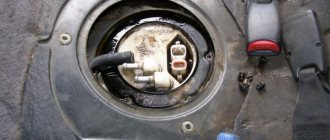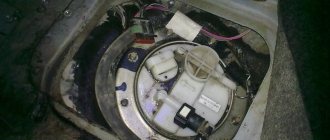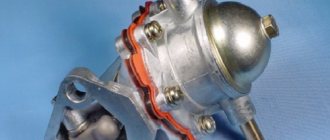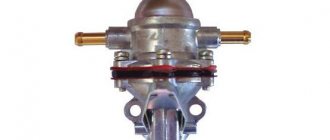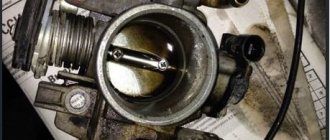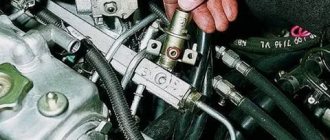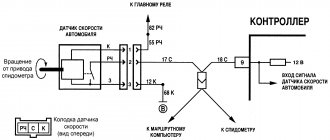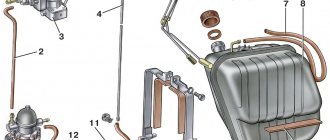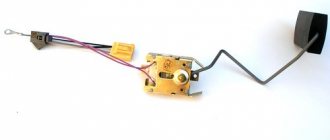The electric fuel pump (EFP) is connected via a 4-pin relay to the following devices:
- with a battery from which the EBN receives power;
- with an ignition switch through which it is started.
The EBN must start almost simultaneously with the starter, since the starter gives the engine an impulse to start, and the fuel pump supplies fuel to the engine. If the fuel pump does not turn on in time and starts pumping gasoline, the car will not start. How to check the fuel pump on a VAZ 2114, why doesn’t the EBL turn on when you turn the ignition key? What problems arise in the electrical circuit, you will learn about this from our article.
Lada 2114 not boring TAZ › Logbook › about the masses
Good afternoon to all VAZ2114 owners! Immediately after the purchase a floating problem appeared. The problem was that sometimes the car refused to start. And as luck would have it, this happened at the most inopportune moment (a couple of times I even had to push the car away at a gas station so as not to disturb anyone). At one of the service stations where I took the car to replace the CV joint, they advised me to replace the fuel pump, since, according to them, the car started only after a good kick to the gas tank. Of course, I also sinned on the fuel pump, but I decided to once again make sure it was working so as not to overpay. I climbed into the gas tank, checked all the contacts with a tester - everything turned out to be in order. The fuel pump is powered directly from the battery - it works like a clock. After this, it was decided to check the wiring going to the fuel pump. And voila, the source of the glitches was found! There were a lot of obscene words!))) It turned out that the mass of the fuel pump was not tightened with a nut, and accordingly the car started only when it wanted)) I would like to immediately explain where the grounding contact of the fuel pump is located. Many people think that it is located on the gas tank itself. This opinion is wrong. It is located under the handbrake. Then I realized why the car wouldn’t start after parking. When putting the handbrake on, the ground contact moved and after that could completely disappear. To get to this contact, you need to remove the plastic tunnel located under the handbrake. The nut that secures the ground wire is located directly next to the attachment of the handbrake to the body; you just need to bend the floor covering. After this incident, it was decided to extend all the contacts of the masses so that there would be no more floating incomprehensible glitches. Additionally, grounding wires were laid from the battery to the generator, from the battery to the body, and from the battery to the central metal bracket on which the ECU is located. And also the ground contacts of the headlights were stretched (thereby getting rid of another glitch. When the reverse gear was engaged, the right turn signals dimly lit up). To summarize everything that has been written, I want to say that the electronics and electrical equipment in our cars require increased attention. And you can get rid of many problems by performing such simple actions. Good luck on the roads!
The non-pump is one of the key components of the VAZ 2114 fuel module. The gasoline pump helps ensure that gasoline is supplied to the engine at the required level of pressure.
Fuel pump for VAZ 2114
Any guarantees from the manufacturer with the actual service life of the fuel pump have little in common, since its durability directly depends on the operating conditions - even the highest quality VAZ fuel pump can quickly fail due to bad gasoline.
OPERATING PRINCIPLE AND DESIGN FEATURES
The VAZ 2114 fuel pump is located inside the car’s gas tank, which is why access to it can be problematic if you don’t know which side to approach. To free up access to the fuel pump, you need to remove the rear seat from the fourteenth, under which you will find a rectangular hatch hiding access to the fuel module.
Just recline the back seat and see for yourself
In addition to the pump itself, the VAZ 2114 fuel module includes:
- A float sensor that monitors the fuel level in the gas tank;
- Chamber for fuel intake;
- Mesh filter for coarse cleaning.
The gasoline pump has a built-in electric motor, which pumps up the pressure of the pumped fuel. The motor itself is powered from the vehicle's on-board network. The VAZ 2114 gasoline pump is located so that even with a minimum level of fuel in the tank, it is constantly washed with gasoline, as this is necessary for normal cooling of the unit, which gets very hot during operation.
The main working element of a gasoline pump is a membrane, which during operation performs reciprocating movements. During normal operation, when the device is fully operational, the following pressure levels must be maintained in the fuel rail:
- For 1.5 l engine. – from 285 to 326 kPa;
- For 1.6 liter engine. – from 375 to 390 kPa.
As evidenced by reviews from owners of fourteenth VAZs, in practice BOSCH pumps have proven themselves to be the best.
Unlike domestically produced units, they cost almost 20-30% more, but at the same time they have an order of magnitude better build quality and reliability. The estimated cost of the fuel module for a 1.5 liter engine of the fourteenth is 2.5 thousand rubles, for 1.6 liters. – 2.6 thousand
However, rational savings are possible here - in most cases it makes sense to purchase a fuel pump separately, rather than the entire module, since, as a rule, the pump itself “dies”, and the remaining parts of the module remain in working order. Its cost, if taken separately, is 1-1.5 tr.
When the ignition is turned on, the fuel pump for the VAZ 2114 injector does not work
The fuel pump of a VAZ 2114 car is one of the key components of the engine fuel system. Designed to pump gasoline to the engine at a pressure of about 300 - 400 kPa (the lower value corresponds to a 1.5-liter engine, the higher value corresponds to an engine with a displacement of 1.6 liters). Regardless of the type used and the manufacturer’s guarantees, its actual service life can vary quite widely, since it is greatly influenced by the quality of gasoline poured into the tank.
Taking into account this feature, during operation the unit may fail and then the problem of replacing it arises. In modern conditions, this procedure is most often carried out in a specialized service workshop. However, if you have the desire, time and minimal plumbing skills, this procedure can be completed independently.
SIGNS OF PETROL PUMP FAILURE
A faulty fuel pump is quite easy to identify, since it is characterized by characteristic signs of failure. For example: while driving, the car suddenly stalls - after turning it on again, the engine begins to make uncharacteristic sounds, while the starter does not stop turning. After the car starts up, the picture repeats itself - the fourteenth engine stalls again. It is also possible that the car starts every once in a while - problems usually arise after sitting at neutral speed.
Let's determine the most typical signs of a fuel pump malfunction:
- The engine refuses to start. Of course, there can be many reasons for this problem - the same spark plugs, or the ECU, but the possibility of a fuel pump malfunction is also worth taking into account;
- The pressure level in the fuel relay differs from normal values;
- The motor is tripping. As a rule, if the fuel pump does not pump as it should, the engine begins to twitch quite noticeably because gasoline is not burned properly in the working cylinders;
- The engine growls at low speeds. One of the most truthful signs, which indicates either an immediate breakdown of the pump, or that the low-purity filter is clogged and the mesh needs to be replaced.
There are quite a lot of possible breakdowns that could cause the fuel pump to fail. The following parts of the unit design can present an unexpected surprise: fuse, fuel pump relay, ground, electric motor, contact system. Let's look at each of them separately.
PRESSURE LEVEL
In order to get most of the picture of what is happening, it is enough to measure the pressure in the fuel rail. For this, it is necessary to use a pressure gauge that has a small measurement range (preferably up to 7 atmospheres), since devices with a large range can produce significant inaccuracies.
Rail pressure measurement
Under the hood of the fourteenth there is a pressure fitting; unscrew its cap and connect the pressure gauge to it. Normal indicators should be as follows:
- When the engine is idling – 2.5 kPa;
- At the moment of ignition - 3 kPa;
- With a pinched drain hose – 7 kPa;
- When gaining speed - 2.5-3 kPa.
If the pressure gauge needle does not move when the ignition is turned on, then the gasoline pressure regulator is most likely broken. When there is no change as the speed increases, the fuel pump itself has failed, but if the needle moves very slowly, which indicates that the pump is pumping, but poorly, the fuel pump screen is clogged.
CHANGING THE PETROL PUMP WITH YOUR OWN HANDS
If the fuel pump in the VAZ does not pump, and all of the above system components are normal, it is necessary to clean the filters, and, if necessary, completely replace the unit.
Before starting work, you must completely drain the fuel from the gas tank. To do everything with our own hands, we need a screwdriver and a set of keys. Replacing the VAZ 2114 fuel pump is carried out according to the following algorithm:
- We de-energize the car by removing the “-” terminal from the battery;
- We take out the rear row of passenger seats;
- Unscrew the plastic cap that covers the pump;
- Remove the power wires from the device and disconnect the fuel supply hoses;
- We dismantle the main fastenings of the fuel pump; for this we need the 7th key;
- Now you can remove the fuel pump on the VAZ 2114 and remove the device.
It must be removed carefully, since the float sensor for determining the fuel level is a very delicate structure that is easy to damage. Inspect the fuel pump - if necessary, clean or replace the strainer, however, it may be necessary to completely replace the unit.
Where is the fuel pump relay located on a VAZ 2114
This is what I have
I get into the car and the injector won’t start! I immediately went to the store and bought 2 relays. I changed it, it started on the on-board vehicle, it showed a break in the main circuit of the non-pump, while I was driving I cleared the errors, turned it off, started the injector, pumped it up, and the ignition was dead, I went back there again, changed the one top relay, started to start, it started making a crackling noise, as if the battery had run out a little, it started up with a bang. The on-board engine did not show any errors, but the injector on the dashboard was on. What to do, what to watch?
1 - fuel pump relay 2 - main relay 3 - fan relay f1 - fuel pump fuse VAZ 2114, VAZ 2115 f2 - main relay circuit fuses.
Thoughts: if the pump is pumping, then there is ground on the solenoid relay or a break in the ignition-starter circuit, I got home, tried to start it, silence, closed it, went home at night, nothing visible and eager to sleep.
Signs of breakdown
There are several situations in which the pump or its components can be at fault. This will definitely have to be checked. Otherwise, you can spend a lot of money buying and installing a new fuel pump, but in the end it turns out that the problem is completely different.
- The engine will not start. This is not a clear sign of problems with the pump, but still. Therefore, first check the condition of the spark plugs, the presence of a spark, and the absence of traces of oil on them. Also check the electronic control unit.
- Pressure inside the fuel system. If the pump is operating normally, it will create a pressure of 3.2 bar. Depending on the type of engine in your VAZ 2114, the characteristics may differ slightly:
- For a 1.5-liter engine, the optimal values are 285-325 kPa;
- For a 1.6-liter engine, these characteristics in optimal operating mode will range from 375 to 390 kPa.
- There is no signal that is not sent to the pump. This happens when you turn the ignition key. During normal operation, the pump begins to vibrate slightly when turning the key. If this does not happen, be sure to check the wiring.
- Troubles the power unit. This is also not an ideal sign of a fuel pump failure. But you still have to check. It is likely that the culprit in this situation will be the pump.
- The engine jerks. Moreover, this happens at low speeds or even at start. There are two possible reasons for the situation - a breakdown of the pump itself or a problem with the fuel pump grid, which will have to be replaced.
New and old coarse filter
Many people purchase the entire fuel module assembly at once, which includes a filter, sensor, float, intake chamber and the pump itself. Such a purchase will cost approximately 3,000 rubles. It is much more profitable and practical to buy a separate pump, which costs up to 1000 rubles. This is due to the fact that when the pump fails, the remaining elements almost always remain intact and are fully suitable for further use.
Yuri Petrovich 12/10/2009 - 15:45
(Cat 302 @ December 10, 2009, 1:42 pm)
The crankshaft position sensor has died, and if there is no signal from this sensor, the controller blocks the fuel pump circuit!
(Cat 302 @ December 10, 2009, 4:13 pm)
It happens Yuri Petrovich. So, on the highway to NG, I’m going out of town to celebrate, I stop for a little emergency, smoke the car in the wilderness, don’t start, I listened to the pump, it’s not making noise, and purely by chance a friend was driving by and it saved me, they brought services, no tools, no tools in the cottage, we went for the DPKV, it didn’t help, we hooked it up directly with wires it works, on holidays we took it to a local service center, where the controller immediately gave an error: a short circuit in the fuel pump network, they replaced the relay, everything rang smoothly, the error remained, the technician came to the conclusion that the controller had burned out and, purely for the sake of experiment, they tried to fix it and lo and behold, the pump started working.
a friend on a new fourteenth car died after six months on the highway, it was cured by replacing the relay, first the relay should be changed Post edited by Rino: 12/10/2009 - 19:33
Pump replacement
Most modern cars are equipped with fuel pumps, which are located inside the fuel tank itself. Because of this, getting to it is quite difficult and such placement raises a lot of questions.
In the case of the VAZ 2114, you can raise the rear seat, under which there is a rectangular hatch. By opening it, you will have access to the pump, a sensor with a float and a coarse filter - a mesh. That is, if necessary, you can easily replace a filter or other element.
There are two fuel wires going to the fuel pump:
- The server. With its help, passing through a fine filter, the ramp and injectors are fed;
- Back. Fuel is returned through the pressure regulator to provide continuous power to the engine.
Now let's talk directly about how to remove and replace a failed fuel pump.
- Be sure to disconnect the negative terminal from your car's battery.
- It is advisable to empty the fuel tank.
- When removing the fuel module, you will be able to get to the bottom of the fuel tank, and therefore have a chance to clean it of all kinds of sediment.
- Release the pressure inside the fuel line. This will prevent a whole jet of fuel from hitting your face or inside the car. To do this, use the measuring nipple on the fuel rail and a thin screwdriver.
- Remove the rear seat to gain access to the hatch that leads us to the fuel module.
- Unscrew the two fasteners holding the hatch cover.
- Disconnect the electrical connector from the module.
- Using a 17mm wrench, unscrew the fuel lines that are connected to the pump. Do this carefully so as not to lose the O-ring. Then move the pipes to the side so that they do not interfere with you.
- Using a 7 mm socket, you need to unscrew the 8 fastening nuts. They hold the pressure plate that holds the entire module in place.
- Remove it carefully through the hole in the fuel tank, but before doing this, do not forget to release the fuel level sensor float.
- If there is a new module, install it in the exact reverse order.
- If only one of the elements needs to be replaced, then you will have to disassemble the fuel module into elements.
- Even a beginner will not have any problems disassembling the module, since the assembly can be disassembled into elements quite easily.
- Perform the reassembly procedure, fill with fuel and check the system for operation.
Replacement process
Pay attention to the type of pump installed. On the new pumps, the mounting system is slightly different. Therefore, for work you will need a ratchet and a 10 mm socket. With their help, the ring is dismantled in a circle and the clamps provided on the fuel line are pressed out.
The procedure for replacing the fuel pump should not cause serious problems. But still be careful, careful and consistent. You work with fuel, and therefore must follow all safety precautions.
Causes of malfunction
- Fuses under the dashboard on the ECU. The top one is 15 A (pump) and the bottom one is 7.5 A (goes to the ECU, to the ignition module).
- Faulty fuel pump relay. It is located there under the torpedo - the very top (below the top fuse).
- Poor fuel module mass. It is mounted under the dashboard, where the handbrake is. The mass needs to be cleaned and re-secured. If it disappears, the fuel level indicator will also not work.
- Lack of positive contact. Removing the back seat. We check the presence of contacts in the wire block. If there is no positive, then the reason is either the relay or the fuse.
- Fuel pump motor not working.
